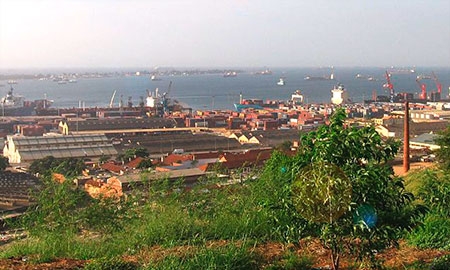With 95% of international trade and importations transiting through ports, it’s no surprise that Angola, a country that is predicted to enjoy one of the highest economic growth rates over the next decade, is pinning a big importance and investing heavily in continued development of its port infrastructure.
As Africa’s biggest oil producer after Nigeria, significant investment has already been made into developing Angola’s ports to ensure crude oil, which accounts for 85% of its $131.8 billion GDP, is smoothly and quickly exported to countries including China, the United States and India. Imports including machinery and electrical equipment, vehicles and spare parts, medicines, food and textiles also arrive into the country’s four major ports – the Port of Cabinda, the Port of Luanda, the Port of Lobito and the Port of Namibe.
The ports, which sit on the South Atlantic Ocean, not only serve Angola’s 19 million people but also act as a gateway to the rest of sub-Saharan Africa, with the country acting as a regional hub to serve countries including Zambia and Zimbabwe. That has meant a big investment in its whole transport infrastructure, with road, rail and air linked seamlessly to complement its busy maritime operations.
“With deep waters, the best roads and railways network of the region, Angola represents a privileged geostrategic place, with more advantages than landlocked countries like Zambia or Zimbabwe,” says Augusto Da Silva Tomás, Minister of Transport for Angola. “With all the rehabilitation and investment plans, we enhance the production not only in Angola, but also in the whole region. We will serve as a basis for neighbouring countries to export themselves and to import.”
The country’s four main ports are all linked with national and international airports that are themselves linked with railways, ensuring a well-integrated transport infrastructure. Mr. Tomás knows the importance of a well-linked network to diversify the economy and development is on-going across the country thanks to Government initiatives.
“Three main corridors are under development,” says Mr. Tomás. “The Corridor for the Development of Luanda that links the port, the airport and the Caminho-de-ferro of Luanda; the Corridor for the Development of Lobito that links the port of Lobito, the airport of Catumbela and the Caminho-de-ferro of Benguela; and the Corridor for the Development of Namibe that links the regional airport, the port and the Caminho-de-ferro of Moçâmedes. We hope to achieve such a corridor for Cabinda and Namibe by the sea, which would then be our 4th corridor for transversal development.” He adds: “Linking ports, airports, railways and fundamental road networks will help project to develop in areas such as in meteorology, energy, water, agriculture, fishing, mining and so on.”
The developments are ensuring Angola is well on-track to become a reference not only in Central Africa but also across the continent and throughout the world. “Investing in these infrastructures, the Government is making it possible for the economy to diversify,” says Mr. Tomás. “Linking ports, airports, railways and fundamental road networks will help project to develop in areas such as in meteorology, energy, water, agriculture, fishing, mining and so on. The next step is to link this enhanced production platform of goods and services to neighbouring countries, like Congo, Zambia and Namibia, through air, maritime, roads and railways agreements.”
Angola’s main port is in Luanda with 11.3 million tons of cargo, or 80% of the country’s imports, processed in the country’s capital. Its importance has resulted in the installation of new cranes and more training to its workforce to reduce cargo unloading time by 80 per cent. Vessel turnaround times have also been cut to an average of three days in 2013 from 16 days in 2008.
That compares with 2.5 days in Durban, the continent’s busiest port in South Africa, but plans are afoot to build Africa’s biggest shipping terminal in Dande, 31 miles north of Luanda. The port will be strategically located to welcome cargo from South and Central America, the U.S., Europe and Asia. The $600 million construction of another port, the Port of Caio in the Cabinda province, has also been given the green light to begin in December.
With ambitious plans comes big financing and although public-private partnerships and Build-Operate-Transfer deals are funding most of the projects, Mr. Tomás says the country welcomes foreign investment. “Our country is open to investors and has no boundaries,” he says. “Anyone willing to contribute to our economic and social development, within the strategy of the State, abiding by our legislation and regulation, will always be welcome.”
That investment looks a safe bet, with Angola’s expanding and improving ports not only playing a key role in strengthening the country’s economy, but acting as a crucial hub for the rest of Africa and the world.

0 COMMENTS